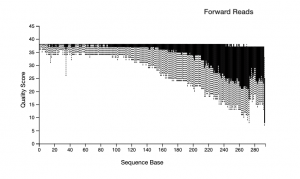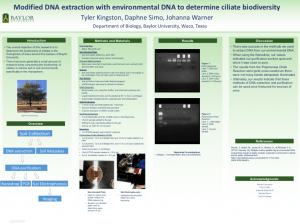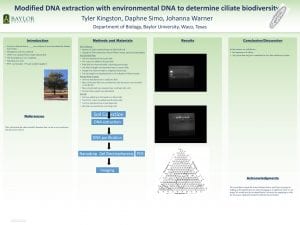Lab 14: Poster Presentation and Abstract Submission
Daphne Simo
04/26/19
I. TITLE
Poster Presentation and Abstract Submission
II. RATIONALE/PURPOSE
The purpose of this lab was to create a finalized version of of our abstract and scientific poster to present at the CURES in Bio Symposium next week. We also completed a spreadsheet that contained metadata for our selected soil samples used for extraction, purification, amplification of the environmental DNA.
III. MATERIALS
Computer
Poster
Abstract
IV. PROCEDURE
Metadata Collection and Soil Sample Labelling
- Label bag and eDNA with your Soil Sample ID.
- Complete the “Soil eDNA Metadata Spring 2019” spreadsheet with the soil sample ID, pH, volume of DNA, PCR results, DNA concentration (ng/μl), Breast Heigh Diameter, GPS location, soil texture, and Genus species of the tree where the soil was collected.
- Complete questionnaire on QTM about t-shirt designs for Cili-CURE and availability to present at the symposium.
Abstract and Scientific Poster Editing
- Work with group members to edit and finalize abstract and scientific poster for submission.
- View feedback from Dr. Adair and the LA/TA to improve abstract and poster.
- Submit abstract and poster to Box and for Week 14 QTM.
V. DATA/OBSERVATIONS
Metadata
|
Group Members Tyler Kingston, Daphne Simo, Johanna Warner |
Section 21 |
Group Number 4 |
Soil ID KSW21_4Sp19 |
GPS Location -97.1146, 31.532 |
Tree Species Quercus imbricaria |
BHD (cm) 34 |
pH 6.5 |
Soil Texture Clay Loam |
Extraction Method Silica Bead |
DNA Concentration (ng/μl) 244 |
DNA Volume (μl) 15 |
PCR Results + |
Soil Label on Bag KSW21SP19 |
Column |
Title of Poster and Abstract
Extraction of environmental DNA from the soil rhizosphere of Shingle Oak tree
The soil rhizosphere of trees have an abundance of ciliates and microorganisms present that have not been subjected to extensive research to analyze their diversity. Ciliates are a group of protists that are distinguished by the absence or presence of cilia. Ciliates are vital in the rhizosphere ecosystem mainly as predators. The purpose of this study was to evaluate the biodiversity of ciliates presence in the rhizosphere of trees on the campus of Baylor University. To determine this, a soil sample was collected at a specific site behind the Student Life Center. The soil sample was then used to find its ph, percent water content, and soil texture. An effective protocol was created to extract and purify DNA from the soil. It included silica beads to break up the cells, charcoal to bind to impurities, and isopropanol was used to purify the DNA using a vacuum. DNA was successfully found from the soil sample and the 18s V4 region was amplified. From there, the future goal is to determine the sequence of the DNA.
Poster
VI. STORAGE
Our finalized abstracts and posters were submitted to Box for future printing.
VII. CONCLUSION
Despite being our second-to-last lab, I believe it was one of the most rewarding session yet. I was able to see all of the work I have done with a single soil sample from campus such as having the ability to extract and purify its DNA and performing a polymerase chain reaction and gel electrophoresis on the eDNA we were able to collect. Furthermore, I have seen advancement in my ability to express my scientific research through writing an abstract and curating a scientific poster.
VIII. FUTURE STEPS
Moving forward, I hope to review all of the processes we have performed on our soil sample this semester and prepare to present my research at the CURES in Bio Symposium in the coming week.













